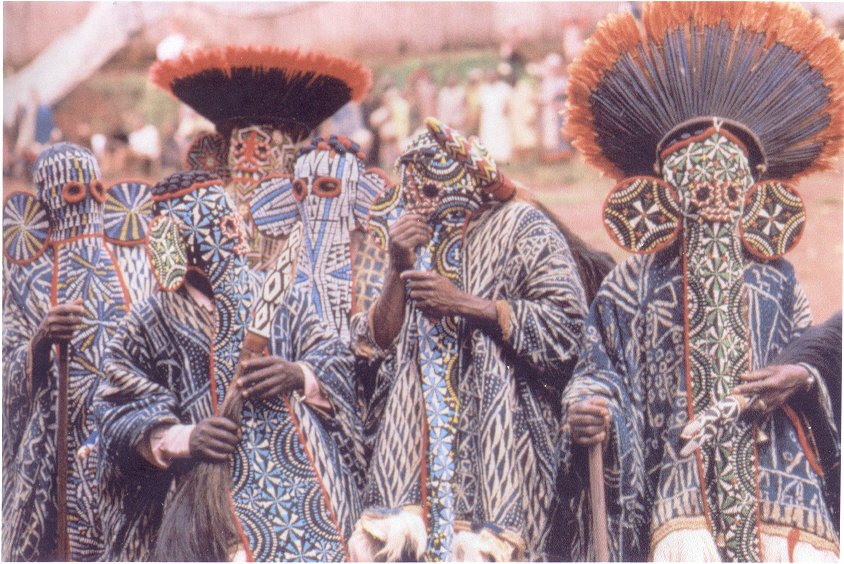Bamileke people
The Bamileke ( in French literature often Bamiléké ) are a West African bantoide ethnic group in the West of Cameroon, in the so-called grasslands of Cameroon, is a resident.
The term Bamiléké goes back to the French colonial administration and is a collective term for approximately 90 small principalities (Chief holidays) in West Cameroon, each a Fon ( chief or local prince) headed by his traditionally organized court. Making the Bamileke as one of the major tribal groups in the country with about 1.5 million members about 10 % of the population of Cameroon from. In Cameroon Grasslands are the largest ethnic group.
Origin and History
Like most of the major ethnic groups of Cameroon Bamileke originally come from the Tikar, who had settled in the country Mbam. They had first settled in what is now the Bamun, ie in the region around the city Foumban. In her current home Bamileke live only since the 18th century. At that time they migrated under the pressure of Bamum further west in the higher altitude region around the towns of Bafoussam, Bamenda and Dschang.
In the years before the independence of Cameroon in the field of Bamileke a war broke out which claimed many victims. The French army was thereby forcibly against people, which were suspected of working for the independence movement union among the peoples of Cameroon. The original rural population of the Bamileke was concentrated in defensive villages. This meant that the economic orientation of the Bamileke ever evolved from agriculture to commerce, from farmers were merchants.
Society, religion, culture
The Bamileke are still alive to this day largely in tribal structures, at the top of each log is the Fon. As in most societies of Central Africa, the family or clan has a priority which usually plays a bigger role than the parent polity even among them.
Today, the Bamileke in Cameroon a reputation as successful traders and businessmen and therefore large influence in commerce, industry and politics. Often top positions in the economy of Bamileke are occupied. In the Bamileke ( Cameroon and to the west in general), there is a tendency to migrate from the countryside into the larger cities. Today, they represent more than half of the residents of Douala and one third of the inhabitants of the capital Yaounde.
Most Bamileke are now Christians, besides sometimes they still practice their ancestral religion of nature. In art they have developed a particularly expressive style, they mainly make portrait statues, magical figures, animal and human masks and ritual equipment manufactures.
Languages
The languages of the Bamileke belong to the language group of the Prairie languages within the Bantoid languages. This forms a subgroup of the Niger - Congo, which also contains the actual Bantu languages. The main languages of the Bamileke are (with the number of alternative names, the ISO language code and the numbers of speakers according to Ethnologue ):
- Fe'fe ' ( Fotuni, Bafang, Nufi ) [ fmp ] (125 thousand)
- Ghomálá ' ( Banjun - Baham, balum, Mahum ) [ bbj ] (250 thousand)
- Kwa ' ( Bakwa ) [ bko ] (in 10 thousand)
- Medumba ( Bagangte, Batongtu, Ndzubuga ) [ BYV ] (210 thousand)
- Mengaka ( Megaka, Ghap, Benzing ) [ xmg ] (20 thousand)
- Nda'nda ' [ nnz ] (10 thousand)
- Ngiemboon ( Nguemba ) [ nnh ] (100 thousand)
- NGOMBA ( Ndaa ) [ jgo ] (65 thousand)
- Ngombale [ nla ] (65 thousand)
- Ngwe ( Nwe, photo, Fontem, Fongondeng, Fomopea ) [ nwe ] (50 thousand)
- Yemba ( Dschang, FOEN, Atsang - Bangwa ) [ ybb ] (300 thousand)
For genetic classification see the article grassland languages.
Some of the Bamileke languages were verschriftlicht during the German colonial period. The national standard colloquial languages , however, are - as in all of Cameroon - French and English.









